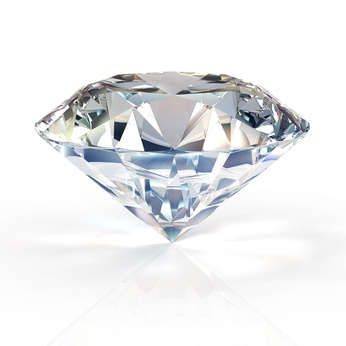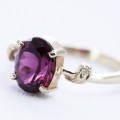Gemstone Visibility: A Point for 4-Prong Settings
One of the most important differences between four- and six-prong rings is in their appearance.

If you are more concerned about how much of your gemstone will be visible, get a four-prong ring.
A ring with four prongs leaves a bigger part of the gemstone mounted in it visible.
If you have a diamond set in your ring, the fewer prongs it has, the more light will enter the stone and the more brilliance it will exhibit.
Four-prong rings also make diamonds mounted in them look bigger.
Six-prong rings, on the other hand, make a stone look smaller as more of its surface is covered by the prongs.
Settings with that many prongs also tend to block more of the light that falls onto the stone from entering it.
As a result, a diamond set in a six-prong setting may look less brilliant and sparkly.
Round Stones Look Better in 6 Prongs
Although gemstones set in a four-prong setting are more visible, such a mounting also makes them look more angular and square as the prongs form a four-point configuration.
This effect is more visible with stones that have a round shape; gemstones with a rectangular cut are not really affected.
In contrast, if you have a round diamond set in a six-prong setting, it will not change the look of the stone’s shape as six prongs won’t create the illusion of a square form.
Check out this selection of different diamond ring settings — with and without prongs.
6-Prong Settings Are Harder to Clean
When it comes to maintenance, the four-prong setting is the winner. Six-prong settings make cleaning the stones set in them harder, especially their lower part, where dirt tends to accumulate.
Generally, the fewer prongs you have, the easier it is to clean the mountings in your jewelry.
4-Prong Settings Are Less Safe
Although six-prong settings do not show off your gemstones as well as four-prong mountings and are also harder to care for, there is one big advantage to having more prongs: They make your ring safer.
Prongs wear down with time, and when they are too worn, they tend to bend and break easily. When one prong in a six-prong setting breaks, you have more intact prongs left to hold your stone than in a four-prong setting.
With four prongs, your gemstone is at a higher risk of coming loose and falling out if a prong is damaged.
6 Prongs Offer Better Protection
Another related advantage to a six-prong setting is that it protects your gemstones better from accidental hits.
Since a stone mounted in such a mounting is covered by more prongs, the gemstone is at a lower risk of chipping or breaking if you accidentally bump your ring.
Stones set in four prongs have less of their surface covered by metal and are thus more exposed to risks of damage.
Choosing Between 4 and 6 Prongs
So, how should you choose between a four-prong and a six-prong setting? It all comes down to what is more important to you: safety or appearance.
If you are more concerned about how much of your gemstone will be visible, get a four-prong ring.
This is an especially good choice if the stone’s shape is not round but rectangular, and if the gemstone is smaller as the four-prong setting will make it look bigger.
If you decide to go with this type of mounting, don’t forget also to inspect it regularly for bent or broken prongs and have any problems fixed as soon as possible.
A six-prong setting is a better choice if you are not that concerned about the visibility of your gemstone.
This is often the case when your stone is bigger. If it is also round, its shape will look better in six prongs. If you care a lot about safety and protection, a six-prong setting will give you more peace of mind.
If you want to get the best of both worlds and have a mounting that makes your stone more visible while being safe, get a four-prong setting made of platinum.
This metal is very durable and wears a lot more slowly than gold or silver, so you won’t have to worry as much about bent or broken prongs.
Where to Buy a Ring?
For diamond, emerald, ruby, or sapphire rings, we recommend James Allen (read review) because you can take a 360-degree look at any stone before having it set in a ring.
Blue Nile is another reputable diamond retailer we recommend.














